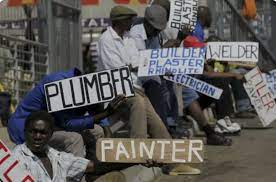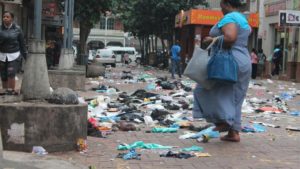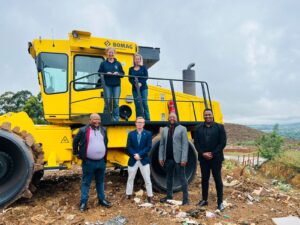(The following DA Motion Debate was delivered during a Sitting of the KZN Legislature held today)
During Youth Month we honour the courage of the young people of 1976 who marched for political freedom in South Africa, so that the next generation could live with dignity and real opportunity. But I want us to hold one young man in mind today and to put a face to the 4.9 million young people that are on the precipice of despair.
Every morning, Steven wakes at 6am, waves goodbye to his mother and little brother, and walks five kilometres to Chatsworth Central. He goes door-to-door, business to business, asking for work. And every afternoon he walks the five kilometres back home – hungry and tired, but hopeful that tomorrow might be different. Weeks become months. Hope turns into worry and eventually into despair. Steven joins millions of young people who are jobless. Worse still, he will become a statistic, one of the millions of young people so discouraged they stop looking for jobs altogether.
Nothing gives hope like a job. Nothing gives dignity like a job. Yet, as of the second quarter of 2025, South Africa’s youth unemployment rate is 46.1%. That is almost one in two young people without work. How is this acceptable? How can we accept that one out of two young people are being robbed of the opportunity to build a life for themselves. And that the situation is getting worse by the day.
Our youth population is growing rapidly, but the economy is not absorbing young people anywhere near the pace required. Too many leave school without strong foundations in literacy, numeracy and digital skills. Too many face the simple barrier of transport money to get to an interview. And with the economy projected to only grow at 1.5% this year, their prospects look bleak.
While government has recognised that we are in the midst of a crisis and has implemented initiatives, the question is – is it moving the dial? Let us be fair and factual in response;
The Presidential Youth Employment Initiative (PYEI) has connected large numbers of young people to short-term opportunities, particularly within Education. This includes the Basic Education Employment Initiative (BEEI), where young people are employed as education assistants or General School Assistants. This is an important stabiliser and a stepping stone into the labour market. When it works well, it is the single largest youth work experience driver in our country’s history.
Also under the Presidential Youth Employment Initiative is the Youth Employment Service (YES) – a business-led model that places our young people into full-time, annual roles. This initiative has a strong private-sector participation. The Democratic Alliance (DA) has engaged with several people who have witnessed how exceptional the YES Programme is in providing an environment for skilling and mentorship. Many of these YES programme participants go on to get a job – between 32% and 42%. The question is: What can we learn from this? The answer is that meaningful work experience can open doors.
While the scale of YES is still too small, relying on voluntary corporate uptake, one way to encourage uptake is to provide incentives to companies through tax incentives. Another challenge is that YES placements remain skewed towards more educated young people, as opposed to those who are uneducated. The take-away is that KZN needs to look at ways to expand these partnerships and to bring as many businesses on board as possible.
KZN’s Youth Empowerment Fund sees applicants apply for grants ranging from R20 000 to R50 000 to kick-start and grow their business ventures in priority sectors and innovation. The fund is directed at encouraging and boosting youth entrepreneurship in our province. This year, the allocation of funds has been beleaguered by accusations of political interference and the unfair allocation of grants.
KZN Premier, Thami Ntuli, has rightfully placed the disbursement on hold and announced that all previous funding applications will be re-evaluated by a newly appointed, independent team. These accusations of fund mismanagement point to the fact that going forward the process needs to involve checks and balances to ensure merit-based allocation. The DA would go further to suggest that a database of recipients be published for public scrutiny to ensure transparency.
Provincial government also needs to determine the impact of the fund: is it moving the dial in terms of youth entrepreneurship? How many jobs has it managed to create, and in what sectors? If indeed, the fund is a roaring success, then it should be scaled up to provide further entrepreneurial support. However, the efficacy of the fund cannot be established without first assessing whether it is indeed contributing to a decrease in youth unemployment in our province.
Our Government of National Unity (GNU) has the potential to do far more to address the youth unemployment crisis. One idea would be to put together a cross-cutting task-team – including EDTEA, Education, Public Works and Agriculture – with one goal – to identify ways to absorb young people into meaningful work opportunities or skills development.
Examples include;
• The Department of Agriculture and Rural Development (DARD) could start a Youth “Farm to Fridge” Co-op, where young people are guaranteed sale of their goods to government school nutrition programmes, clinics and hospitals and;
• EDTEA, Public Works and Education, working together, could train our youth to install and maintain rooftop solar and basic energy-efficiency kits at schools and clinics and other government facilities.
These are just two examples of many that could be implemented to fast-track youth employment initiatives in KZN. The DA also proposes that all Moses Kotane Digital Hubs operate as open-access skills and placement centres with AI and coding bootcamps – with monthly public reports on footfall, course completions, certifications and job outcomes. I have been to some of these centres and I can tell you from firsthand experience that it was painful to see them empty and under-utilised when we are in the midst of the 4th industrial revolution.
However, these efforts – worthy as many are – do not yet add up to an engine that consistently pulls young people into lasting work at scale. Far too many state assets – which could be used to drive economic growth and employment – remain standing idle.
The DA recognises this and has launched a campaign that clearly sets out six key interventions that could turbo-charge South Africa’s economy to create employment for its people;
1. Get rid of job-killing policies and laws by removing regulatory roadblocks, overhauling race-based empowerment schemes and creating an enabling environment for investment, entrepreneurship and job creation
2. Fix South Africa’s energy crisis by creating a competitive electricity market and unlocking energy exports to create an affordable and reliable electricity supply that promotes economic growth and job creation
3. Turn around our failing railways, ports and digital infrastructure to restore South Africa’s position as a competitive, connected and modern economy
4. Refocus public expenditure on productive investments, eliminating waste and bailouts and support sustainable, pro-growth public finances
5. Turn collapsing municipalities into functioning centres of service delivery by stabilising coalitions, professionalising administrations, unlocking investment, and devolving powers to capable local governments
6. Crack down on organised crime and corruption, professionalise policing, and decentralise public safety to capable provinces and municipalities.
The message is clear – we need to get the basics right!
Proof that these policies work can be found in the DA-led Western Cape and City of Cape Town. In the Western Cape, youth unemployment is around half the national average while more than 80% of people who want to work in the Western Cape get a job – this is the highest in South Africa. Importantly, the Western Cape is investing R2.96billion over three years in youth opportunity interventions to ensure our young people have the right skills, the right qualifications and the right experience for jobs available now and in the future.
Some of the Western Cape initiatives adopted to help young people get jobs include;
– The Jobseeker Travel Voucher Programme, which offers job seekers free bus rides to job interviews
– The City of Cape Town partnership with business process outsourcing (call centres) to create job opportunities for youth with no tertiary qualification
– The ‘YearBeyond’ programme which has offered quality work experience to 7 846 ‘Yeboneers’ since 2019 and which will be ramped up so that between 3 000 and 4 000 youth will benefit annually. At least 70% of these young people will go on to further their studies or go on to find gainful employment
– The MasakhiSizwe Bursary Programme, unique to the Western Cape, which has seen 865 young people supported to pursue their dreams of obtaining an opportunity to study in the infrastructure field at partner higher education institutions and;
– The First Work Experience PAY Programme, which aims to create opportunity for matriculants to gain workplace experience within the Western Cape Government (WCG). The internship allows for a year of mentoring, decision-making about a future career, on-the-job training and exposure to skills training and development to make an intern more employable.
Here in KZN, tomorrow morning Steven will still rise at 6am and walk five kilometres to the centre of Chatsworth. It is within the power of KZN’s Government of Provincial Unity (GPU) to decide whether Steven and many like him are walking towards a job and hope – or whether they will once again turn back in disappointment, tired and hungry.
If the GPU – of which the DA is a proud partner – acts with urgency and aligns the state, private sector and skills pipelines, Steven’s walk could symbolise a generation’s first steps out of despair into dignity. This is our call to action, and we must answer.








